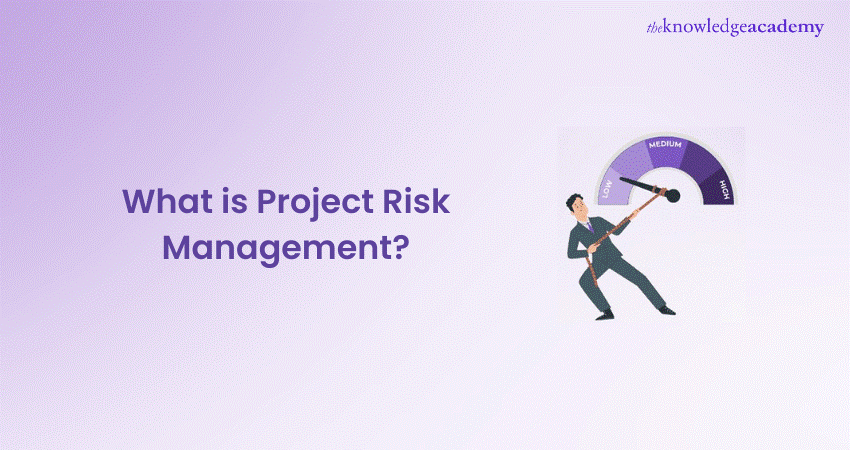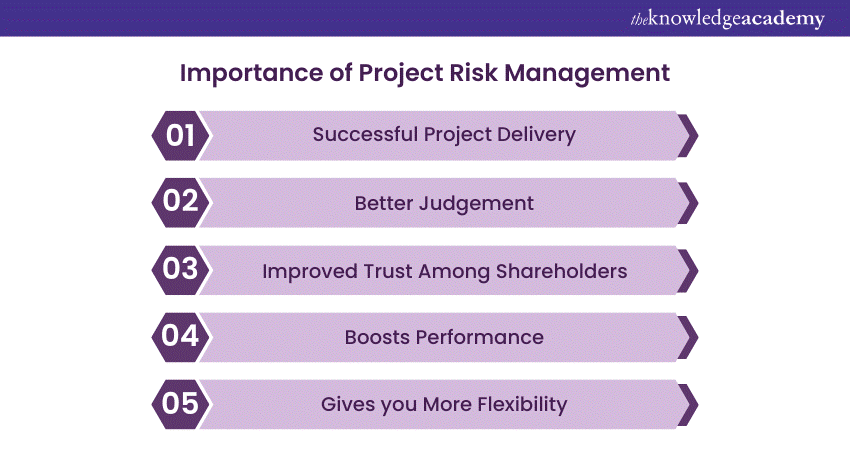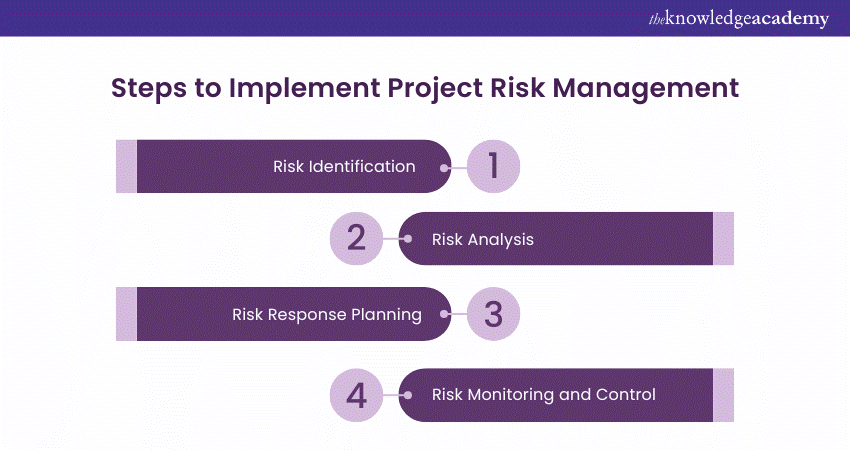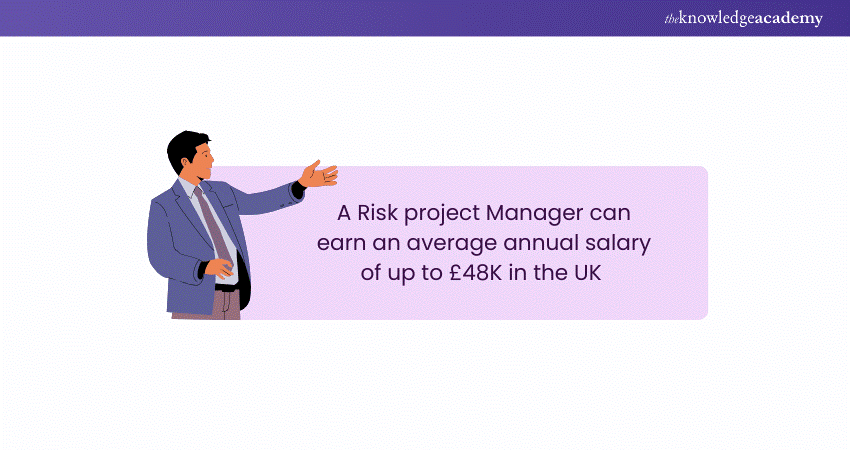We may not have the course you’re looking for. If you enquire or give us a call on + 1-866 272 8822 and speak to our training experts, we may still be able to help with your training requirements.
We ensure quality, budget-alignment, and timely delivery by our expert instructors.

Risks and progress are two parts of the same coin: Project Management. As every project has its share of twists and turns, Project Risk Management comes to your aid, helping you navigate the inevitable uncertainties with ease. It's the art of spotting potential pitfalls, bracing for the unexpected, and keeping the ship steady. If you are seeking deeper insight into this process, look no further. This blog uncovers what Project Risk Management truly means, explores its benefits, best practices, and more. So, read on and master the craft of turning dreaded setbacks into confirmed success!
Table of contents
1) What is Project Risk Management?
2) Importance of Project Risk Management
3) Steps Involved in Implementing Project Risk Management
4) How Does Risk Management Ensure Project Success?
5) Tools and Techniques for Effective Project Risk Management
6) Best Practices for Project Risk Management
7) Conclusion
What is Project Risk Management?
Project Risk Management is the method of identifying, assessing, and addressing potential risks that may impact the project's success. It involves proactively identifying and examining risks followed by development and implementation of strategies to mitigate those risks.
The primary goal of Project Risk Management is to minimise the likelihood and impact of negative risks (threats) while maximising the potential presented by positive risks (opportunities). Risk Management should be an integral part of project planning and execution, involving the collaboration of project stakeholders, team members, and relevant experts. It requires a structured approach, supported by effective tools and techniques, to systematically identify, analyse, and respond to risks.

Importance of Project Risk Management
Effective Project Risk Management holds immense importance in ensuring project success. Here are key reasons why it is crucial:

Ensuring Project Success
Effective Risk Management significantly increases the chances of a project’s success by detecting potential risks and developing strategies to address them. It helps avoid or mitigate risks impacting project timelines, budgets, quality, and overall objectives.
Proactive Decision-making
Risk Management enables proactive decision-making by providing insights into potential risks and their consequences. With a comprehensive understanding of risks, Project Managers can make informed decisions and allocate resources effectively to mitigate or exploit risks.
Stakeholder Confidence
A robust Risk Management approach enhances stakeholder confidence. By demonstrating a proactive and systematic approach to managing risks, project teams instil trust and reassurance among stakeholders. This confidence fosters stronger relationships and better collaboration throughout different stages of the project lifecycle.
Improved Project Performance
Effective Risk Management undoubtedly contributes to improved project performance. Project teams can minimise disruptions, delays, and unexpected costs by anticipating and addressing risks. Here's how it is applicable:
Project Execution: Predicting risks well in advance assist in smoother project execution.
Resource Allocation: It enables better handling and allocation of resources and ensures effective resource utilisation.
Budget and Time: Increased chances of delivering projects on time and within budget due to effectively managing risks and resources.
Maximising Opportunities
Risk Management not only focuses on mitigating risks but also on maximising opportunities. By identifying and capitalising on positive risks, project teams can leverage potential advantages and enhance project outcomes. This proactive approach enables the exploration of innovative solutions and potential project enhancements.
In summary, Project Risk Management is of utmost importance in ensuring project success. It empowers project teams to proactively manage risks, make informed decisions, and optimise project performance. Through integration of Risk Management practices into project planning and execution, organisations can enhance their ability to navigate uncertainties and achieve desired project outcomes.
Level up your Risk Management skills with our Certified Risk Management Professional (CRMP) Course. Sign up now!
Steps Involved in Implementing Project Risk Management
Implementing Risk Management practices involves several key elements that contribute to its effectiveness. These elements provide a structured approach to managing risks throughout the project lifecycle. The key elements of Project Risk Management are:

Risk Identification: Identifying Potential Risks
When it comes to Risk Management, identification of potential risks is the first step. This involves systematically identifying and documenting risks that may impact the project’s success. Some of the techniques that can be used to identify risks across different project stages include:
a) Brainstorming
b) Solid checklists
c) Expert judgement
Risk Analysis: Assessing and Evaluating Risks
Once risks are detected, they need to be analysed and evaluated to understand the likelihood of potential impact on the project. Risk analysis involves assessing the probability of occurrence and the magnitude of consequences associated with each identified risk. This analysis helps prioritise risks and determine the level of attention and resources required for their management.
Risk Response Planning: Devising Strategies to Mitigate Risks
Based on the analysis of identified risks, project teams develop risk response plans. These plans outline the strategies and actions to be taken to mitigate or exploit risks. Risk response planning involves selecting appropriate risk response strategies, such as:
a) Risk avoidance
b) Risk mitigation
c) Risk transfer
d) Risk acceptance
Risk Monitoring and Control: Ensuring Effective Risk Management
Risk monitoring and control are ongoing processes that ensure successful Risk Management throughout the project lifecycle. It involves:
a) Tracking identified risks
b) Monitoring their status and changes
c) Implementing necessary adjustments to risk response plans
Regular communication, documentation, and reporting of risk-related information enable stakeholders to stay updated on the progress of Risk Management activities.
These elements form the foundation of a comprehensive Risk Management framework, enabling project teams to proactively manage risks and amplify the likelihood of project success.
Take your Project Risk Management expertise to the next level with our MoR® 4 Practitioner Risk Management Certification Course. Sign up now!
How Does Risk Management Ensure Project Success?
The integration of Risk Management with the project plan is crucial for achieving desired outcomes. Here are key aspects of integrating Risk Management into project success:
Ensuring Project Success Through Effective Risk Management
By incorporating Risk Management practices from the project initiation stage, project teams can significantly enhance the chances of project success. This proactive approach helps in avoiding potential pitfalls and keeps the project on track towards achieving its objectives. Here are the measures that can help ensure project success:
a) Early Detection of Risks: Identifying and addressing risks early on allows for proactive planning and helps better tackle the risks and challenges
b) Proper Resource Allocation: Allocating resources in advance where the threats are most likely to occur can help manage them efficiently
c) Risk Mitigation Strategies: By implementing the best practices, you can minimise the likelihood of threats and risks as well as their impact.
Enhancing Decision-making With Risk Management insights
Risk Management provides valuable insights that can help in decision-making throughout the project lifecycle. By considering potential risks and their impacts, Project Managers can make informed decisions and develop contingency plans in People Risk Management. Here's how Risk Management insights assist project teams:
a) Analyse Various Scenarios: It helps you analyse various scenarios as well as provides you insights on how to handle them.
b) Evaluate Alternatives: By analysing various scenarios, you can come up with various plans to mitigate risks.
c) Courses of Action: You can implement the various courses of action to manage and overcome threats and risks.
Mitigating Project Failures With Proactive Risk Management
Proactive Risk Management helps mitigate project failures. By identifying and addressing risks in advance, project teams can reduce the likelihood of unforeseen events derailing the project. Here's how proactive Risk Management is applicable:
a) Early detection of potential issues
b) Allows timely interventions
c) Take appropriate actions to mitigate or eliminate risks
Risk Management is a crucial aspect of successful project delivery. By understanding its significance and implementing these steps, project teams can ensure the stability, resilience, and success of their projects. By integrating Risk Management with project success, organisations can enhance decision-making, mitigate project failures, and maximise opportunities for achieving project objectives.
Tools and Techniques for Effective Project Risk Management
The following are some of the best Project Risk Management tools and techniques Project Managers use to build Risk Management plans and guard against inevitable risks and changes:
1) Risk Management Plan Template: This is used to identify, evaluate and control threats to a project. This template gathers all the pertinent information needed to identify and mitigate risks in one place.
2) Risk Register: This tool identifies and describes the risk. It then provides space to explain the potential impact on the project and the well-structured response to dealing with the risk if it occurs risk if it occurs. Additionally, the risk register enables a Project Manager to prioritise the risk, assign an owner responsible for its resolution, and provide a place to add notes as needed.
3) RAID Log: RAID stands for Risks, Assumptions, Issues, and Decisions. This tool is used during the project's planning and execution phases. It monitors risks, assumptions, and decisions, allowing project teams to manage them during the decision-making process.
4) Risk Breakdown Structure (RBS): This is a hierarchical framework that categorises risks associated with the project. It helps project teams to break down the risks into small, more manageable components.
5) Root Cause Analysis: This systematic process identifies the fundamental risks embedded in the project, emphasising that good management is responsive and preventative. It can be applied to risk assessment by going through the goals of any root cause analysis, which asks the following questions:
a) What happened?
b) How did it happen?
c) Why did it happen?
Once those questions are answered, a plan of action can be developed to prevent it from happening again.
6) Probability and Impact Matrix: This technique combines individual risks' probability and impact scores and ranks them according to their severity. This way, each risk is understood in the context of the larger project, so if one does occur, there’s a plan in place to respond.
Stand Out in Your Risk Management Interview – Review Essential Risk Management Interview Questions Now!
Best Practices for Project Risk Management
As explained above, Risk Management is a Project Manager's most important tool. Consider these five best practices as you implement your project’s Risk Management plan:
1) Assign a Risk Manager: Having someone solely dedicated to Risk Management is critical to preventing risks from getting overlooked or falling through the cracks. This person must have the skills to anticipate which risks could become problematic and ensure the risk management plan is being followed.

2) Continuous Risk Monitoring: Projects are dynamic processes, making monitoring potential risks and mitigation strategies essential throughout the project's lifecycle. Regular risk assessments ensure you have up-to-date information before any decisions impact the project.
3) Maintain Clear and Transparent Communication: Open communication enables your team members to flag any risks that may have otherwise gone unnoticed. Emphasising the importance of direct and clear communication with the entire team can prevent this from happening to your project. Additionally, openly communicating risks with the project sponsor and stakeholders is essential.
4) Implement Risk Accountability for Every Team Member: Risk Management is every team member’s responsibility. Everybody in the project owns all project risks at the respective levels in which they operate. Creating a risk-aware work culture can increase risk accountability among all team members, regardless of their role.
5) Consider Opportunities (Not Just Threats): Positive risks are uncertain events that may benefit your project, helping the work go faster. However, project teams often get bogged down by the day-to-day work that needs to be done immediately, creating a dynamic where only bad risks are important. Make sure to carve out time to handle opportunities in the project, even if it takes only an hour a week.
Conclusion
In conclusion, mastering Project Risk Management is an essential skill for Project Managers and the ideal recipe for project success. Through the proactive identification, assessment, and mitigation of risks, teams can fortify their objectives, optimise resources, and improve project resilience. A well-structured risk strategy will turn uncertainties into opportunities and empower your team to navigate challenges confidently.
Enhance your Project Risk Management skills and ensure project success with our comprehensive MoR® Management of Risk Courses. Sign up today!
Frequently Asked Questions
What are the Five Risk Management Strategies in Project Management?

The five Risk Management strategies in Project Management are:
a) Identify risks
b) Analyse potential risk impact
c) Assign priority to risks
d) Mitigate risks
e) Monitor risks
What are the Golden Rules of Project Risk Management?

The golden rules are:
a) Make Risk Management Part of Your Project
b) Identify Risks Early in Your Project
c) Communicate About Risks
d) Consider Both Threats and Opportunities
e) Clarify Ownership Issues
f) Prioritise Risks
g) Analyse Risks
h) Plan and Implement Risk Responses
i) Register Project Risks
j) Track Risks and Associated Tasks
What are the Other Resources and Offers Provided by The Knowledge Academy?

The Knowledge Academy takes global learning to new heights, offering over 3,000 online courses across 490+ locations in 190+ countries. This expansive reach ensures accessibility and convenience for learners worldwide.
Alongside our diverse Online Course Catalogue, encompassing 19 major categories, we go the extra mile by providing a plethora of free educational Online Resources like News updates, Blogs, videos, webinars, and interview questions. Tailoring learning experiences further, professionals can maximise value with customisable Course Bundles of TKA.
What is The Knowledge Pass, and How Does it Work?

The Knowledge Academy’s Knowledge Pass, a prepaid voucher, adds another layer of flexibility, allowing course bookings over a 12-month period. Join us on a journey where education knows no bounds.
What are the Related Courses and Blogs Provided by The Knowledge Academy?

The Knowledge Academy offers various MoR® Management of Risk Courses including the MoR® 4 Practitioner Risk Management Certification and the Certified Risk Management Professional (CRMP) Course. These courses cater to different skill levels, providing comprehensive insights into MoR® Benefits for Organistions and Individuals.
Our Project Management Blogs cover a range of topics related to Project Risk Management, offering valuable resources, best practices, and industry insights. Whether you are a beginner or looking to advance your Risk Management skills, The Knowledge Academy's diverse courses and informative blogs have got you covered.
Upcoming Project Management Resources Batches & Dates
Date
 Certified Risk Management Professional CRMP
Certified Risk Management Professional CRMP
Thu 10th Apr 2025
Thu 15th May 2025
Thu 17th Jul 2025
Thu 18th Sep 2025
Thu 13th Nov 2025






 Top Rated Course
Top Rated Course


 If you wish to make any changes to your course, please
If you wish to make any changes to your course, please


